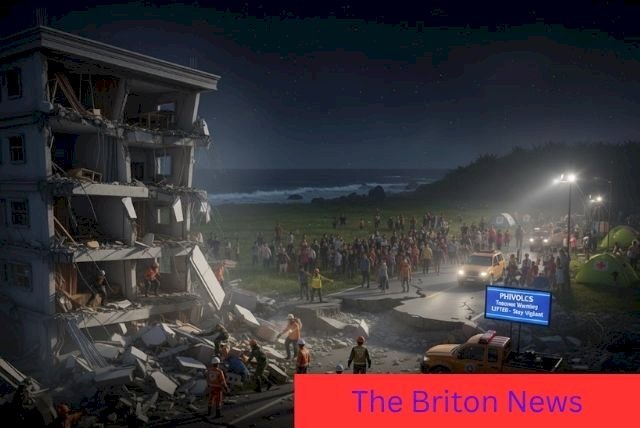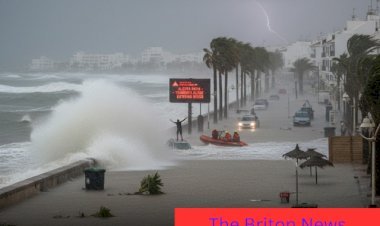7.4 Earthquake Hits Mindanao — Tsunami Alert, Casualties, and Damage Reported
A magnitude 7.4 earthquake struck Mindanao, Philippines, prompting tsunami alerts, evacuations, and casualties. Read about the impact, rescue operations, and government response.

A powerful 7.4 magnitude earthquake struck Mindanao, the southern region of the Philippines, late Friday night, triggering widespread panic and prompting a tsunami alert across several coastal provinces. The earthquake occurred at around 10:36 p.m. local time on October 10, 2025, with its epicenter near Surigao del Sur, according to the Philippine Institute of Volcanology and Seismology (PHIVOLCS).
The quake, one of the strongest to hit the region in years, caused severe shaking, damaged infrastructure, and led to casualties and mass evacuations in coastal towns. Within minutes, authorities issued a tsunami warning for the eastern seaboard of Mindanao and nearby islands.
What Happened: Timeline of the Quake
According to PHIVOLCS, the main 7.4 magnitude quake originated 25 kilometers deep in the seabed off Hinatuan, Surigao del Sur. The tremor was felt across Davao, Butuan, General Santos, and even parts of Visayas, causing residents to flee their homes.
Within hours, more than 60 aftershocks were recorded — some reaching magnitudes of 4.5 to 5.2. Emergency sirens echoed across coastal towns as local officials urged residents to move to higher ground.
The Pacific Tsunami Warning Center (PTWC) initially issued advisories not only for the Philippines but also for Indonesia, Palau, and Malaysia, warning of potential small tsunami waves.
Immediate Impact and Casualties
By Saturday morning, authorities confirmed at least 11 people dead and more than 100 injured across several provinces. Many of the victims were hit by falling debris or trapped under collapsed homes.
The city of Bislig reported widespread power outages, while in Davao Oriental, several bridges and schools were damaged. Hospitals in Surigao and Butuan were temporarily evacuated as precautionary measures.
Local authorities also reported landslides in hilly areas of Agusan del Sur and Compostela Valley, blocking key roads and hampering rescue operations.
Tsunami Warnings and Coastal Evacuations
Immediately after the main quake, PHIVOLCS issued a tsunami warning for Mindanao’s eastern coastline, including Surigao del Sur, Davao Oriental, and Agusan del Sur.
Thousands of residents living near the coast were ordered to evacuate to higher ground. In Hinatuan Bay, small waves measuring between 10 to 25 centimeters were recorded, but no destructive tsunami occurred.
By 2:45 a.m., after monitoring coastal activity, authorities lifted the tsunami warning, stating that no significant sea level changes were observed. However, officials urged residents to remain vigilant due to ongoing aftershocks.
Rescue and Relief Operations
The Philippine government immediately mobilized rescue and response teams. President Ferdinand Marcos Jr. directed the National Disaster Risk Reduction and Management Council (NDRRMC) to coordinate with local government units for relief distribution and search operations.
The Philippine Army, Coast Guard, and Red Cross volunteers were deployed to clear debris, locate missing persons, and deliver food and medical supplies to affected areas. Emergency shelters were set up in Tandag City, Hinatuan, and Davao Oriental for displaced families.
The Department of Social Welfare and Development (DSWD) distributed emergency food packs, bottled water, and sleeping kits. Health teams were also dispatched to prevent disease outbreaks in temporary shelters.
Human Stories from the Ground
Residents described the quake as one of the most terrifying nights of their lives.
“The ground moved like waves. We grabbed our children and ran outside,” said Maria Santos, a resident of Hinatuan.
Another survivor from Bislig City, Joel Ramirez, recalled seeing cracks appear on the road and walls collapsing within seconds of the shaking. Many residents spent the night in open fields or higher ground, fearing aftershocks or another tsunami.
In coastal communities, fishermen lost boats and small equipment to the strong waves. Emotional support teams have been deployed to help children and elderly people coping with trauma.
Scientific Explanation: Why Mindanao Is Prone to Quakes
Mindanao lies along the Pacific Ring of Fire, one of the most seismically active regions in the world. The Philippine Sea Plate constantly pushes against the Eurasian Plate, creating deep trenches and fault lines around the island.
The Mindanao Trench, located just off the eastern coast, is a subduction zone — where one tectonic plate slides beneath another — making it highly prone to large earthquakes and potential tsunamis.
Scientists explained that the recent 7.4 earthquake was caused by sudden movement along the subduction boundary, similar to other historic quakes in the area. PHIVOLCS noted that while the quake was powerful, its depth and offshore location helped reduce the overall destruction on land.
Aftershocks and Continuing Risk
As of Saturday morning, PHIVOLCS reported more than 60 aftershocks throughout Mindanao. The strongest aftershock measured magnitude 5.2, shaking already damaged structures and prompting residents to remain outdoors.
Authorities warned that aftershocks may continue for several days, and residents were advised to stay away from damaged buildings and steep slopes.
Power restoration efforts are underway, but some areas remain without electricity due to damaged transmission lines. The Department of Energy assured that repair teams are working round-the-clock to restore services.
International Support and Global Response
International organizations quickly responded to the disaster. The United Nations Office for the Coordination of Humanitarian Affairs (OCHA) and Japan International Cooperation Agency (JICA) expressed readiness to provide technical support and relief supplies.
Neighboring countries like Indonesia and Malaysia issued statements of solidarity, offering emergency assistance if required.
Major international news outlets such as BBC, CNN, and Reuters covered the event, highlighting both the Philippines’ rapid disaster response and the community resilience shown by Mindanao residents.
Government Recovery and Rebuilding Plans
In a televised address, President Marcos Jr. assured the nation that rehabilitation and rebuilding would begin immediately after rescue operations. The Department of Public Works and Highways (DPWH) has begun assessing damaged bridges and public facilities.
Meanwhile, psychological support teams have been deployed to assist survivors suffering from trauma, especially children who experienced the quake firsthand.
The government also reminded citizens about the importance of earthquake preparedness — keeping emergency kits ready, identifying safe zones, and participating in community drills.
Conclusion
The 7.4 magnitude earthquake in Mindanao has once again reminded Filipinos of the country’s exposure to natural disasters. While the tsunami alert has been lifted and aftershocks continue to decline, the road to recovery will be long for affected communities.
Thanks to the quick response by authorities and the cooperation of residents, a major loss of life was prevented. However, the widespread damage to homes, schools, and infrastructure underscores the urgent need for continued investment in disaster resilience and public awareness.
As Mindanao rebuilds, the strength and unity of its people continue to shine — proving that even in the face of natural calamities, the Filipino spirit stands unbroken.
At Briton News, we stand with the people of Mindanao and remain committed to bringing accurate updates, human stories, and recovery efforts as the region heals and rebuilds.
FAQs on the Mindanao Earthquake
1. What caused the 7.4 magnitude Mindanao earthquake in 2025?
The 7.4 magnitude Mindanao earthquake was caused by the movement of tectonic plates along the Mindanao Trench, where the Philippine Sea Plate slides beneath the Eurasian Plate. This area is part of the Pacific Ring of Fire, one of the world’s most active seismic zones.
2. When and where did the Mindanao earthquake occur?
The Mindanao earthquake struck on October 10, 2025, at 10:36 p.m. local time. Its epicenter was located near Hinatuan, Surigao del Sur, in the southeastern part of the Philippines.
3. Was there a tsunami after the Mindanao earthquake?
Yes, a tsunami alert was issued after the Mindanao earthquake. Small waves between 10 to 25 centimeters were recorded along the coast, but no destructive tsunami occurred. The warning was lifted after several hours of monitoring.
4. How many people were affected by the Mindanao earthquake?
According to early reports, at least 11 people were killed and more than 100 others injured. Thousands were displaced as homes, schools, and roads were damaged across Surigao del Sur, Davao Oriental, and nearby areas.
5. How strong was the shaking during the Mindanao earthquake?
The shaking from the Mindanao earthquake was classified as intense to very strong in several provinces. Many residents reported difficulty standing, and objects fell from shelves, while some buildings sustained visible cracks.
6. Why is Mindanao prone to earthquakes?
Mindanao sits along the Pacific Ring of Fire, where several major tectonic plates meet. This makes it vulnerable to frequent earthquakes and volcanic activity, especially along deep ocean trenches like the Mindanao Trench.
7. What is PHIVOLCS’ role during the Mindanao earthquake?
The Philippine Institute of Volcanology and Seismology (PHIVOLCS) monitors earthquakes, issues tsunami warnings, and provides public safety advisories. During the Mindanao earthquake, PHIVOLCS coordinated with local agencies to ensure timely evacuations and accurate data updates.
8. How can residents stay safe during earthquakes like the one in Mindanao?
Residents should Drop, Cover, and Hold On during shaking, stay away from glass and heavy furniture, and move to open areas once it’s safe. Coastal communities should follow tsunami evacuation routes immediately after strong offshore quakes like the Mindanao earthquake.
9. What are aftershocks, and are they still happening in Mindanao?
Aftershocks are smaller tremors that follow a major quake. Following the Mindanao earthquake, more than 60 aftershocks were recorded, some strong enough to cause minor additional damage. Authorities warn that aftershocks may continue for several days.
10. How is the Philippines government responding to the Mindanao earthquake?
The Philippine government launched nationwide relief and rescue operations after the Mindanao earthquake. Agencies like the NDRRMC, DSWD, and Philippine Red Cross are providing emergency supplies, shelter, and psychological support to affected communities.














